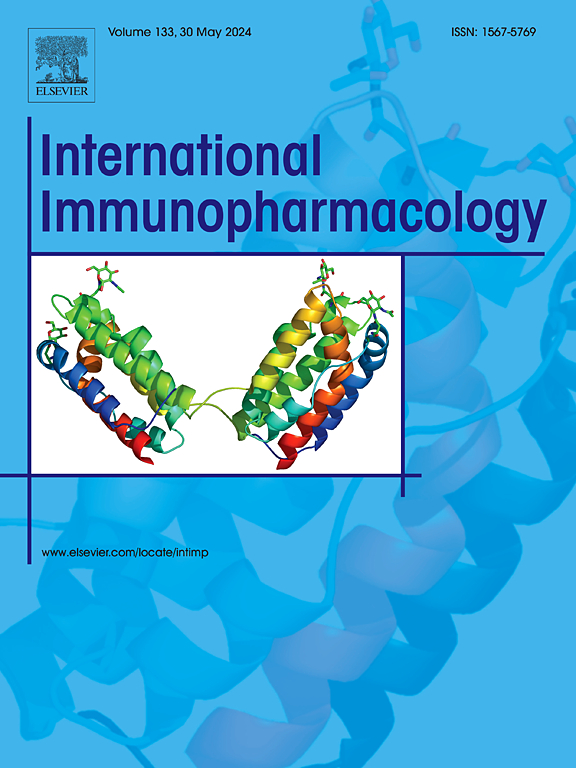Colchicine inhibits myocardial pyroptosis and reduces myocardial cell injury after myocardial infarction through the ESR1-PI3K-Akt-NF-κB signaling pathway
IF 4.8
2区 医学
Q2 IMMUNOLOGY
引用次数: 0
Abstract
Background and purpose
Inflammation serves as a critical driver in coronary artery disease pathogenesis. Emerging clinical evidence demonstrates that low-dose colchicine therapy significantly reduces ischemic event incidence in patients with coronary heart disease while attenuating myocardial ischemia-induced inflammatory cascades. Nevertheless, the precise cardioprotective mechanisms underlying colchicine—a plant-derived anti-inflammatory agent—in limiting post-infarction cardiomyocyte injury remain incompletely elucidated. This study systematically investigates colchicine's myocardial preservation mechanisms through an integrated experimental approach.
Method
To establish experimental models of myocardial injury, we performed permanent ligation of the left anterior descending coronary artery (LAD) in mice for in vivo studies, while HL-1 mouse atrial cardiomyocytes were treated with 0.3 mM H₂O₂ to induce oxidative stress in vitro. Following successful model validation, colchicine was administered to both systems. Comprehensive evaluations included echocardiographic assessment of cardiac function, histological examination of inflammatory infiltration and collagen deposition through H&E and Masson's trichrome staining respectively, quantitative analysis of cardiomyocyte apoptosis by flow cytometry, and Western blot detection of key signaling pathway components and pyroptosis-related proteins (including NLRP3, caspase-1, and GSDMD).
Result
Our experimental data revealed that colchicine treatment significantly attenuated myocardial injury and fibrosis while improving cardiac function (P < 0.05). Mechanistically, colchicine administration reduced proinflammatory cytokine release (IL-1β and IL-18), decreased neutrophil infiltration, and suppressed cardiomyocyte pyroptosis. These cardioprotective effects were associated with modulation of the ESR1-PI3K-Akt-NF-κB signaling pathway (P < 0.05), suggesting a potential therapeutic mechanism for colchicine in myocardial protection.
Conclusion
Colchicine inhibits myocardial pyroptosis and reduces myocardial cell injury after myocardial infarction through the ESR1-PI3K-Akt-NF-κB signaling pathway.

秋水仙碱通过ESR1-PI3K-Akt-NF-κB信号通路抑制心肌梗死后心肌焦亡,减轻心肌细胞损伤
背景与目的炎症在冠状动脉疾病的发病机制中起着重要的驱动作用。新出现的临床证据表明,低剂量秋水仙碱治疗可显著降低冠心病患者缺血事件的发生率,同时减轻心肌缺血引起的炎症级联反应。然而,秋水仙碱(一种植物来源的抗炎剂)在限制梗死后心肌细胞损伤中的确切心脏保护机制仍未完全阐明。本研究采用综合实验方法系统探讨秋水仙碱的心肌保护机制。方法采用永久性结扎冠状动脉左前降支的方法建立心肌损伤实验模型,并在体外用0.3 mM h2o2诱导HL-1小鼠心房心肌细胞氧化应激。在成功的模型验证后,秋水仙碱被施用于两个系统。综合评价包括超声心动图心功能评估,H&;E和Masson’s三色染色组织学检查炎症浸润和胶原沉积,流式细胞术定量分析心肌细胞凋亡,Western blot检测关键信号通路成分和焦亡相关蛋白(包括NLRP3、caspase-1、GSDMD)。结果实验数据显示,秋水仙碱治疗可显著减轻心肌损伤和纤维化,改善心功能(P <;0.05)。从机制上说,秋水仙碱可以减少促炎细胞因子(IL-1β和IL-18)的释放,减少中性粒细胞的浸润,抑制心肌细胞的焦亡。这些心脏保护作用与ESR1-PI3K-Akt-NF-κB信号通路的调节有关(P <;0.05),提示秋水仙碱具有心肌保护的潜在治疗机制。结论秋水仙碱通过ESR1-PI3K-Akt-NF-κB信号通路抑制心肌梗死后心肌焦亡,减轻心肌细胞损伤。
本文章由计算机程序翻译,如有差异,请以英文原文为准。
求助全文
约1分钟内获得全文
求助全文
来源期刊
CiteScore
8.40
自引率
3.60%
发文量
935
审稿时长
53 days
期刊介绍:
International Immunopharmacology is the primary vehicle for the publication of original research papers pertinent to the overlapping areas of immunology, pharmacology, cytokine biology, immunotherapy, immunopathology and immunotoxicology. Review articles that encompass these subjects are also welcome.
The subject material appropriate for submission includes:
• Clinical studies employing immunotherapy of any type including the use of: bacterial and chemical agents; thymic hormones, interferon, lymphokines, etc., in transplantation and diseases such as cancer, immunodeficiency, chronic infection and allergic, inflammatory or autoimmune disorders.
• Studies on the mechanisms of action of these agents for specific parameters of immune competence as well as the overall clinical state.
• Pre-clinical animal studies and in vitro studies on mechanisms of action with immunopotentiators, immunomodulators, immunoadjuvants and other pharmacological agents active on cells participating in immune or allergic responses.
• Pharmacological compounds, microbial products and toxicological agents that affect the lymphoid system, and their mechanisms of action.
• Agents that activate genes or modify transcription and translation within the immune response.
• Substances activated, generated, or released through immunologic or related pathways that are pharmacologically active.
• Production, function and regulation of cytokines and their receptors.
• Classical pharmacological studies on the effects of chemokines and bioactive factors released during immunological reactions.

 求助内容:
求助内容: 应助结果提醒方式:
应助结果提醒方式:


